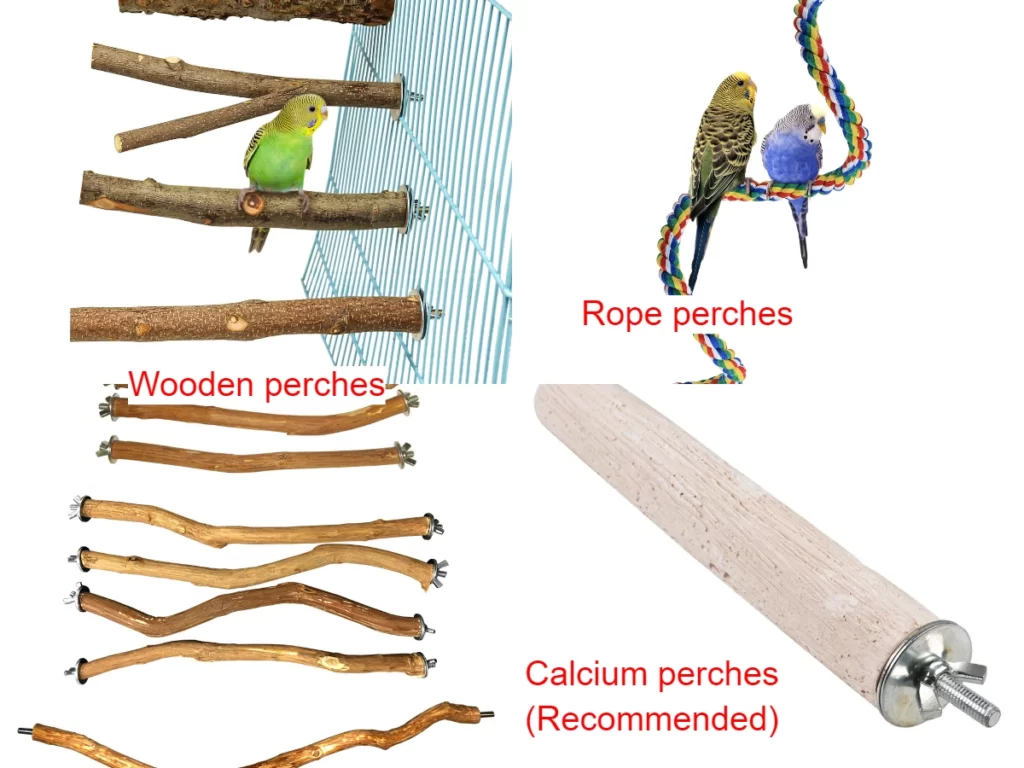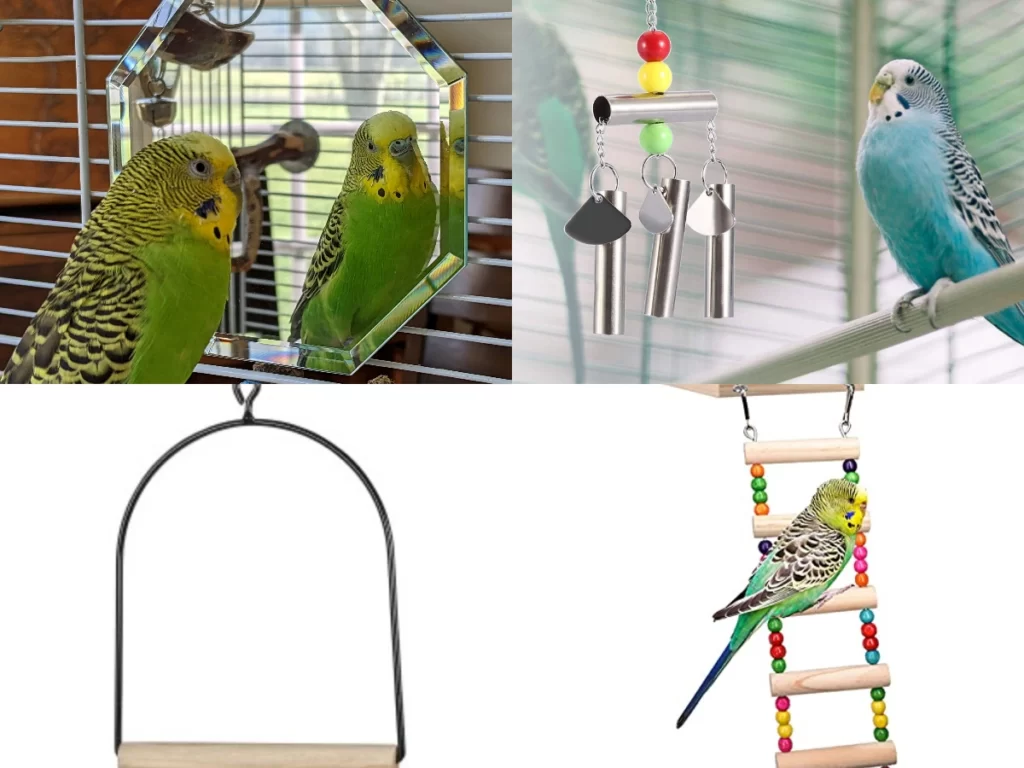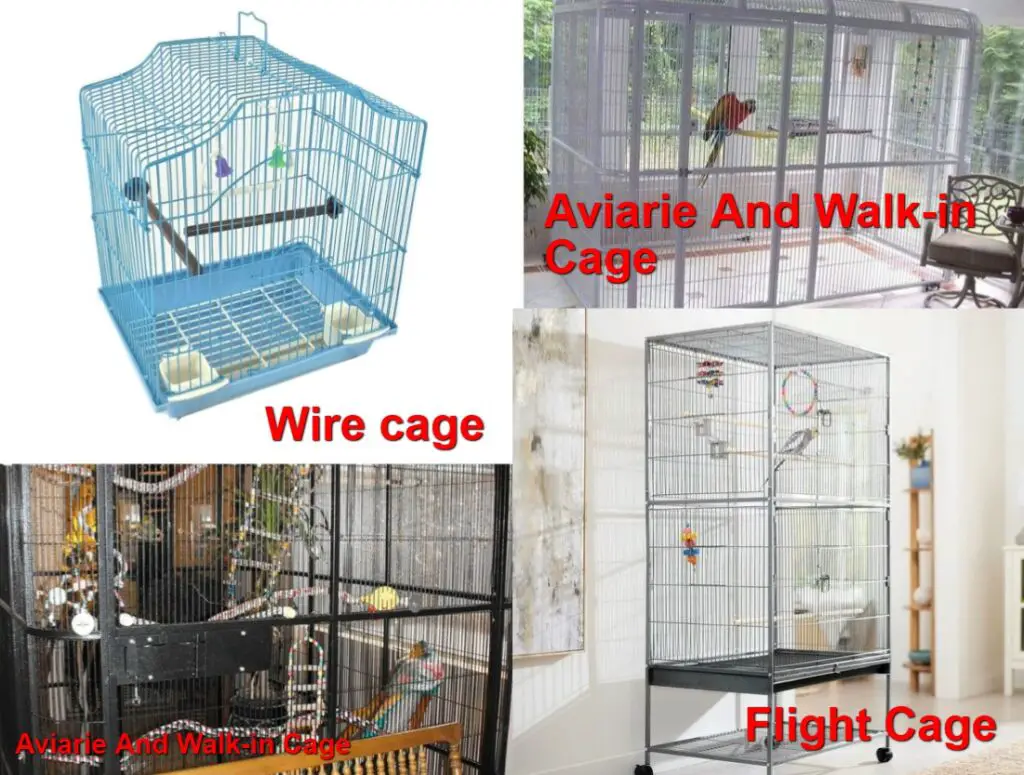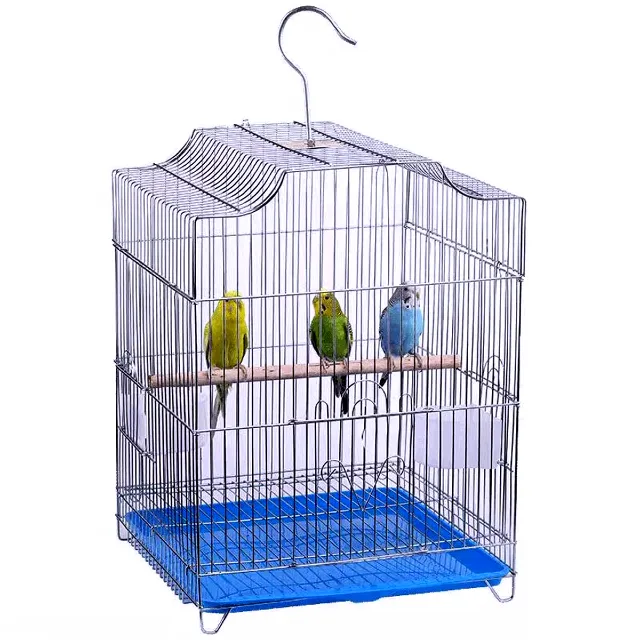Picture a place that can be both a sanctuary and a playground for your budgie – a well-equipped cage! Imagine you are a budgie, and you see your cage not just as a structure of metal bars, but as your world, where you experience life in all its diversity.
Understanding the concept of a budgie cage from this perspective becomes crucial for any budgie owner.
This budgie cage guide encompasses information about accessories, cage setup, types of cages, determining the number of budgies per cage size, material considerations, and homemade cage options.
What is a budgie cage? A budgie cage is essentially a budgie’s home.
This is the place where your feathered friend will eat, sleep, play, and interact with the world around it.
Every aspect of the cage, from its size and material to the placement of perches and toys, contributes to the health and happiness of your budgie.
As such, understanding the nuances of a budgie cage is vital for every budgie parent.
Having spent considerable time around budgies, both professionally and personally, I am here to help guide you in creating an enriching habitat for your feathered friend.
Budgie Cage Accessories
Perches
Perches form a crucial part of any budgie’s cage.
They not only provide a place for your budgie to rest but also help in exercising their feet.
There is a variety of perches available in the market, each offering unique benefits to your budgie.

Importance Of Different Perch Sizes And Materials
Having perches of different sizes and materials in your budgie’s cage encourages foot exercise, preventing conditions like bumblefoot.
Your bird spends much of its day on its feet, and variety is key to maintaining their health.
Recommended Perch Types (Natural Wood, Rope, Calcium)
Natural wood perches are the closest your budgie can get to their natural environment.
They are irregular in shape, which exercises different parts of the foot.
Rope perches are soft and comfortable for your bird, while calcium perches serve the dual purpose of a perch and a source of calcium, contributing to the health of your budgie’s beak and nails.
Where Should Perches Be Placed In The Cage?
Placement of perches is an important consideration.
Avoid placing perches directly above food or water dishes to prevent contamination.
You can place them at varying heights to encourage flight and exercise.
Remember, your bird should be able to move freely without bumping into toys or accessories.
Toys And Enrichment
Toys provide the necessary stimulation for your budgie’s active and inquisitive mind.

Swings
Budgies love swings! They provide an excellent source of exercise and entertainment for your budgie.
Ladders
Ladders offer your budgie a fun way to climb around the cage and exercise its legs and feet.
Bells
Bells can provide auditory stimulation.
However, ensure the bell cannot trap your bird’s beak or feet.
Mirrors
While some budgies enjoy mirrors, they may lead to obsessive behavior in others.
Monitor your budgie’s interaction with mirrors closely.
Types Of Toys For Mental And Physical Stimulation
Toys such as puzzles, foraging toys, and chew toys can offer both mental and physical stimulation for your budgie.
Safety Considerations When Choosing Toys
Always ensure the safety of toys.
They should be non-toxic and should not have small, detachable parts that your budgie could swallow or get tangled in.
Food And Water Dispensers
Options For Convenient And Clean Feeding
Choosing the right food and water dispensers for your budgie cage is essential for maintaining cleanliness and promoting convenient feeding.
Opt for dishes that are easy to refill and clean.
They should also be sturdy to prevent tipping.
Some budgie owners prefer dishes with a hood or cover to keep the food and water clean and reduce spillage.
These come in different materials, including stainless steel and durable plastics.
Automatic feeders and water dispensers are another option.
They keep a constant supply of food or water, reducing the need for frequent refills.
However, it’s essential to monitor these to ensure your budgie always has fresh supplies and to maintain hygiene.
Tips For Choosing Suitable Dispensers
Selecting the right dispensers for your budgie involves several considerations.
Firstly, opt for dispensers that are easy to clean.
This reduces the chance of bacterial growth and keeps the feeding area hygienic.
Secondly, consider the size of the dispenser in relation to your budgie and the cage size.
It should be comfortably accessible to the bird but not so large as to take up too much space.
Thirdly, the material of the dispenser is important.
Stainless steel is often recommended due to its durability and ease of cleaning.
However, sturdy plastic can also be a good choice.
Lastly, ensure the dispenser can be securely attached to the cage to prevent it from being knocked over.
Some budgie owners prefer dispensers with a cover to prevent the bird from soiling its food or water.
Cuttlebone And Mineral Block
Cuttlebones and mineral blocks provide essential minerals like calcium and help maintain your budgie’s beak health.
Secure these items in a place your budgie can easily access.
Bird Bath
Some budgies love water and enjoy bathing.
A bird bath can offer this enrichment.
Ensure it is shallow and secure it well inside the cage.
Nest Box
If you plan on breeding your budgies, a nest box is necessary.
It provides a safe and private space for your budgie to lay eggs.
Cage Cover
A cage cover can help regulate your budgie’s sleep cycle by blocking out light and disturbances during the night.
Cage Liner
Cage liners simplify the cleaning process.
You can use newspaper or specialized cage liners available in pet stores.
Night Light
Contrary to popular belief, budgies do not need night light.
It may even prevent your budgie from getting a good night’s sleep.
Heat Lamp
A heat lamp can provide supplemental warmth for your budgie during colder months.
Ensure it doesn’t make the cage too hot or lead to overheating.
Types Of Budgie Cages
Choosing the right type of cage for your budgie is pivotal to their well-being.
The type of cage you opt for should accommodate your bird’s needs and behavior adequately.

Wire Cages
Wire cages are among the most common types of budgie cages available due to their affordability and practicality.
Advantages And Disadvantages
Wire cages allow good ventilation, are often easy to clean, and provide plenty of opportunities for your budgie to climb and explore.
However, the bars’ spacing should be small enough to prevent your budgie from getting its head stuck.
The coating should also be non-toxic as budgies are prone to chewing the bars.
Factors To Consider When Choosing A Wire Cage
Consider the cage’s size, bar spacing, and the quality of the coating when choosing a wire cage.
Additionally, ease of access for cleaning and feeding, and the cage’s overall security should be taken into account.
Flight Cages
Flight cages are larger than standard cages and allow budgies to fly around, a vital aspect of their behavior.
Benefits Of Flight Cages For Budgies
Flight cages provide your budgie with the space to fly, contributing significantly to their physical health and mental well-being.
They can accommodate multiple perches, toys, and other accessories without cramping the cage.
Features To Look For In A Suitable Flight Cage
An ideal flight cage should be wider than it is tall to allow for horizontal flight.
The bar spacing, as with wire cages, should be narrow enough to prevent escape or injury.
Aviaries And Walk-in Cages
Aviaries and walk-in cages provide ample space for multiple budgies to fly and socialize.
Overview Of Larger Enclosure Options
These larger enclosures are suitable if you have multiple budgies.
They allow for ample flight space and can mimic a budgie’s natural environment more closely.
Pros And Cons Of Aviaries And Walk-in Cages
While aviaries offer ample space and a more natural living situation, they also require more maintenance and may not be suitable for all climates.
They also need to be predator-proof if placed outdoors.
Budgie Cage Materials
The materials used in making budgie cages not only impact their durability and appearance but also affect your budgie’s health.
Metal Cages
Metal cages are common due to their durability and strength.

Common Types Of Metal Used In Budgie Cages
Common metals used include stainless steel, which is robust and non-toxic, and powder-coated metal, which is durable and comes in various colors.
Safety Considerations And Potential Hazards
Ensure that the metal does not contain lead or zinc as these can be toxic if ingested.
Also, be aware of any sharp edges or points that could harm your budgie.
Acrylic Cages
Acrylic cages are a modern alternative to traditional wire cages.
Advantages And Disadvantages Of Acrylic Cages
Acrylic cages offer a clear view of your budgie and are usually easy to clean.
However, they lack the ventilation provided by wire cages and may not offer your budgie the climbing opportunities that wire bars provide.
Suitable Situations For Acrylic Cages
Acrylic cages may be suitable for temporary housing, such as during travel, or for budgies with specific health issues that necessitate their use.
They may not be suitable as a permanent housing solution.
Hybrid And Alternative Materials
In addition to metal and acrylic, cages made from other materials exist.
Introduction To Cages Made From Alternative Materials (Bamboo, Pvc, Etc.)
Bamboo cages can have an attractive, natural appearance, but may not be as durable as metal.
PVC cages can be lightweight and easy to clean, but like acrylic, they do not offer climbing opportunities like wire cages.
Considerations For Using Unconventional Cage Materials
When using unconventional cage materials, ensure they are safe and non-toxic.
Consider their longevity, ease of cleaning, and the impact on your budgie’s behavior.
What Kind Of Material Should I Buy A Budgie Cage Made Of So That It Can Be Cleaned More Easily?
Stainless steel or powder-coated metal cages are generally easy to clean.
Their non-porous surface prevents waste and food from sticking and can be wiped clean.
What Kind Of Material Should I Buy A Budgie Cage Made Of For Budgie Health?
Stainless steel is an excellent material for budgie cages as it’s safe, durable, and easy to clean.
Wire cages also provide the benefit of exercise through climbing.
Avoid materials that can chip or have toxic coatings.
Number Of Budgies And Cage Size Guide
When it comes to the well-being of your budgie, the size of the cage plays an important role.
The number of budgies you plan to keep and the space they need to thrive are crucial elements to consider.
As a rule of thumb, the minimum requirement space area for a budgie in a cage is around 12 inches wide, 18 inches long, and 18 inches tall (30.5 cm wide, 45.7 cm long, and 45.7 cm tall).
However, these numbers are simply the bare minimum.
The more space your budgies have, the happier and healthier they will be.
Here is a general guideline table that shows the minimum and recommended space requirements for budgies in inches and cm:
| Number of Budgies | Minimum Space Requirement (inches) | Minimum Space Requirement (cm) | Recommended Space Requirement (inches) | Recommended Space Requirement (cm) |
|---|---|---|---|---|
| 1 | 12x18x18 | 30.5×45.7×45.7 | 18x18x18 | 45.7×45.7×45.7 |
| 2 | 30x18x18 | 76.2×45.7×45.7 | 39x20x20 | 99×50.8×50.8 |
| 3 | 48x18x18 | 121.9×45.7×45.7 | 60x24x24 | 152.4×60.9×60.9 |
| 4 | 60x24x24 | 152.4×60.9×60.9 | 72x36x36 | 182.9×91.4×91.4 |
| 5 | 72x24x24 | 182.9×60.9×60.9 | 84x36x36 | 213.3×91.4×91.4 |
| 10 | 120x48x48 | 304.8×121.9×121.9 | 144x60x60 | 365.8×152.4×152.4 |
| 15 | 180x60x60 | 457.2×152.4×152.4 | 216x72x72 | 548.6×182.9×182.9 |
| 20 | 240x72x72 | 609.6×182.9×182.9 | 288x84x84 | 731.5×213.3×213.3 |
| 30 | 360x84x84 | 914.4×213.3×213.3 | 432x96x96 | 1097.2×243.8×243.8 |
How Big Should A Cage Be For 2 Budgies?
For two budgies, it’s recommended to have a cage that measures at least 39 inches wide, 20 inches long, and 20 inches tall (99 cm wide, 50.8 cm long, and 50.8 cm tall).
What Is The Best Size Cage For A Budgie?
The best size cage for a budgie would provide ample room for flight.
A good rule of thumb would be at least twice the wingspan of your bird in width, and the length should be at least four times the bird’s size.
Can You Have Two Budgies In A Cage?
Yes, you can have two budgies in a cage.
Budgies are social creatures and often appreciate the company.
However, ensure the cage is large enough to prevent squabbles and allow each bird space to fly and explore.
Can A Budgie Cage Be Too Big?
In theory, a budgie cage cannot be too big, as budgies appreciate as much space as you can provide.
However, ensure the bars’ spacing is appropriate, and the cage is secure from potential predators if it’s placed outdoors.
Homemade Budgie Cages
Designing and constructing your own budgie cage can be a rewarding process.
It enables customization to your specific requirements.
Benefits And Considerations Of Building A Homemade Budgie Cage
A homemade budgie cage allows customization, potential cost savings, and can be a fulfilling project.
However, ensure that the materials used are safe and non-toxic for your budgies.
Also, consider ventilation, ease of cleaning, and security.
DIY Cage Design Ideas And Tutorials
Several resources online provide comprehensive guides and tutorials on how to build a homemade budgie cage.
These range from simple designs to more complex structures.
Some utilize wood, others wire or PVC.
Always consider your budgie’s needs when planning a DIY cage.
I personally do not have experience in making a budgerigar cage, but in the video here, some very nice budgie cage works are done. You have to watch. Thank to Alen AxP youtube channel.
Faqs
Where Is The Best Place For A Budgie Cage To Stand Constantly?
The best place for a budgie cage is in a quiet, well-lit room where the temperature is consistent.
Avoid areas with drafts, direct sunlight, or excessive noise.
The cage should be at eye level and not in the kitchen due to potential hazards from cooking fumes.
What Are The Must-have Accessories In A Budgie Cage?
Essential accessories in a budgie cage include perches of varying sizes and materials, food and water dishes, cuttlebone, toys for mental and physical stimulation, and a cage liner for easy cleaning.
How Can I Ensure The Safety Of My Budgie When Choosing Cage Accessories?
To ensure your budgie’s safety, avoid toys with small parts that can be swallowed or loose strings that can entangle the bird.
Choose perches of varying diameters to promote foot health and select food and water dishes that are easy to clean.
Avoid using materials that can chip or are coated with toxic substances.
Why Is The Size And Type Of The Cage So Important For Budgies?
The size and type of the cage are crucial for a budgie’s health and well-being.
Budgies need ample space to move and fly, so the cage should provide sufficient room.
Additionally, the type of cage affects behaviors like climbing and the ability to interact with cage accessories.
What Are Some Good Materials For Homemade Budgie Cages?
Some good materials for homemade budgie cages include untreated wood, stainless steel wire for the cage bars, and non-toxic plastic for the base.
Ensure that the materials used are sturdy, safe for birds, and easy to clean.
What Are Some Key Tips For Maintaining A Clean Budgie Cage?
Keeping a budgie cage clean is critical for the bird’s health.
Regularly change the cage liner, wash food and water dishes daily, and clean perches and toys as needed.
Deep-clean the entire cage periodically using bird-safe cleaning products.
![Budgie aviaries [Ideas, Sizes, Materials, Setup, Indoor, Outdoor]](https://www.petiska.com/wp-content/uploads/2022/05/budgie-aviaries-ideas-sizes-materials-setup-indoor-outdoor-1652196499-400x300.jpg)

![Budgie Cage Size Guide [Minimum & Size Calculator Table]](https://www.petiska.com/wp-content/uploads/2022/08/budgie-cage-size-guide-minimum-size-calculator-table-1659974199-400x300.jpg)